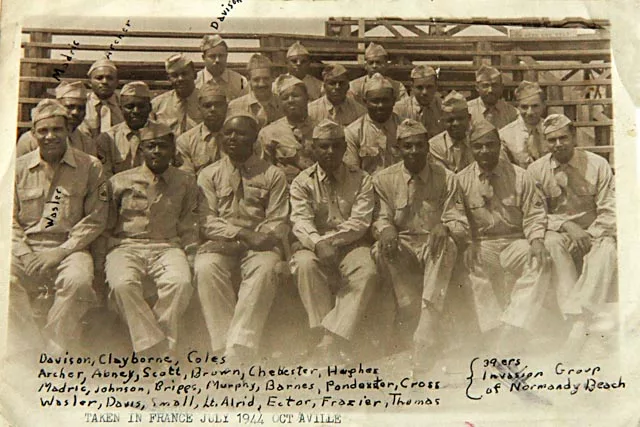
Photo: Members of the 320th who survived D-Day posed for a photograph. The names were written on the photo by one of the men, the late George Davison. (Photo courtesy of Bill Davison/Collection of Shannon McFarlin).
Paris, Tenn.—On the 80th anniversary of the D-Day invasion, it is important to remember the men from Camp Tyson in Paris who made history on that day.
Soldiers with the U.S. Army’s 320th Barrage Balloon Battalion, who were trained at Camp Tyson, were the only African-American unit to participate in the Allied invasion.
The men of the 320th served bravely and heroically on that day—which they had trained for months at Camp Tyson, which was the United States’ only barrage balloon training facility. Of course, the men of the 320th did not know that is what they were training for as the D-Day invasion was a top secret.
The legacy of the men had been largely lost to history until the publication of the books, “As If They Were Ours: The Story of Camp Tyson, America’s Only Barrage Balloon Training Facility” and “Images of America: Camp Tyson”; and “Forgotten: The Untold Story of D-Day’s Black Heroes, At Home & At War”.
The books, “As If They were Ours” and “Images of America: Camp Tyson” were written by Shannon McFarlin of Paris, Tenn., and “Forgotten” was written by Linda Hervieux of New York City.
Of the men who served, only one, William Dabney of Roanoke, Virginia, was publicly honored for his achievements when he received the Legion of Honor in Paris France on June 6, 2009.
In the book, “As If They Were Ours”, Dabney recalled, “We knew we were going to take part in the invasion” as June 1944 approached. General Eisenhower came on the loud speaker on the ship and said, ‘Some of you will not be returning’. That got you upset a bit, hearing that.”
What made Dabney and other members of the 320th different from the other battalions at D-Day was that they were attached to the heavy barrage balloons as they came off the ship and onto the beaches.
Dabney said, “I had my balloon attached to my belt. I remember flying in the air from the strength of the balloon when we came off the landing board.” The balloon was shot out from under Dabney and he immediately disconnected the cable and threw himself on the sand.
George Davison, whose story also was told in “As If They Were Ours”, said, “It was hell.” When the battle was over and dawn approached, the men could see the bodies of Allied soldiers floating in the water.
Many of the barrage balloons used at D-Day were manufactured at Camp Tyson in Paris. Why did they play such an important role? When the huge balloons were in the air, planes could not make a diving bomb run or strafe while in battle because the balloon was blocking their view of the soldiers on the ground.
Davison’s son, Bill, who was interviewed for “As If They Were Ours”, said his father did receive service medals, but he did not receive anything specific for his service during D-Day.
As D-Day was being planned, the U.S. military deemed that the barrage balloons and the men who knew how to operate them would be an essential elementary of the operation.
Caldwell Monk, who served with the 320th, also was interviewed for “As If They were Ours” and lamented the lack of attention that the battalion received for its actions at D-Day. “We were there. We did our part,” he said.
Photo: The men of the 320th of Camp Tyson on Omaha Beach. NARA photo.



